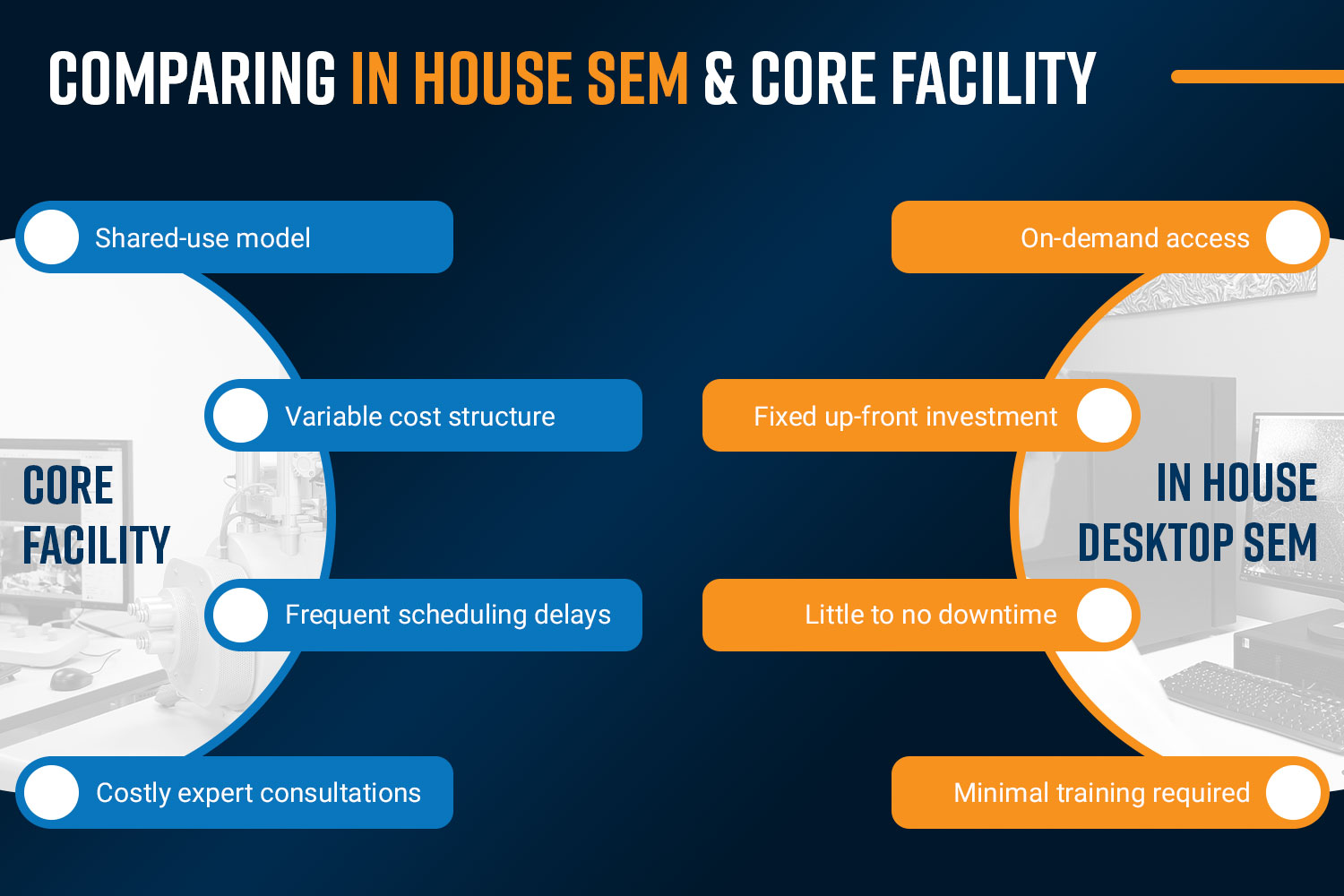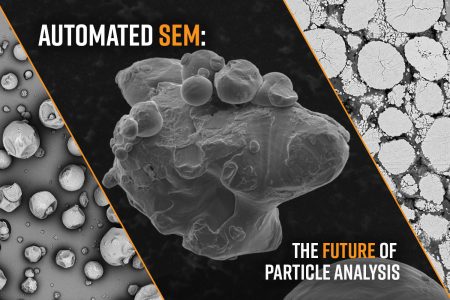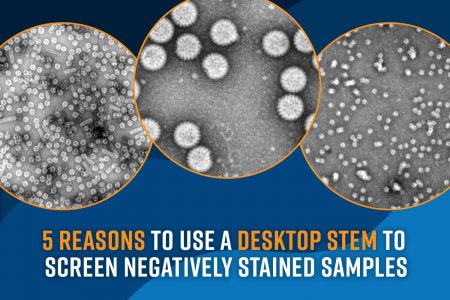Scanning electron microscopy (SEM) is an essential tool that allows scientists to directly visualize the surface structure and composition of a variety of materials on the nanometer to micrometer scale. The decision between utilizing a core facility for SEM services or investing in in-house SEM is a critical one that researchers often grapple with. Both options offer distinct advantages and implications for efficiency, cost-effectiveness, and research outcomes. In this blog post, we explore the key factors influencing this decision-making process, delving into the benefits and drawbacks of both approaches.

Accessing SEM Services through a Core Facility
Core facilities serve as centralized hubs offering shared access to instruments, technologies, and services, alongside expert consultation and other resources for scientists and researchers. They are often found at larger institutions such as universities and enterprise organizations. Electron microscopy core facilities typically house multiple high-end SEM equipment accompanied by technical staff, enabling individuals to complete SEM projects without needing to be experts themselves.
Depending on where your work is located, you may have direct access to a core facility through your organization or have the option to commute to an external core facility. While core facilities are widely depended on and used by many, they come with inherent challenges that are important to be aware of:
Access and Scheduling
Core facilities operate on a shared-use basis, which means you are competing for access with other researchers. This competition can lead to scheduling delays, making it difficult to align the SEM analysis portion of a project with the rest of its timeline. Such constraints are particularly disruptive to time-sensitive projects, where delays can mean missed opportunities or prolonged durations. Unscheduled downtime is another challenge that is more likely to occur in a shared-use model. This is because the larger number of users combined with the complexity of higher-end SEMs increases opportunities for repairs that could result in your reservation being delayed.
Cost Structures
Utilizing SEM capabilities through a core facility typically involves a fee-for-service model. Charges accumulate based on usage time, with potential additional fees for technical support or specialized services like sample preparation. Many core facilities use a prorated model wherein industrial users are required to pay a higher rate than academic users. While this model provides access to expensive equipment without the need for individual labs or organizations to bear the full cost of housing and operating their equipment, it can add significant expense to a project’s budget, especially for long-term research.
Expertise and Training
Staff experts who maintain the equipment can provide valuable assistance or training in core facilities. They are a great resource for researchers who may not have a background in electron microscopy. However, reliance on facility staff can also prove to be a detrimental bottleneck, as the experts’ availability can further complicate scheduling and access. On the other hand, training can allow a user to become an independent operator but requires significant up-front investment to complete the necessary training.
The Appeal of In-House Desktop SEM
Thanks to the widespread availability of desktop (synonymously benchtop and tabletop) systems, SEM has become more accessible than ever. Their compact footprint, easy-to-use software, and expansive capabilities, like automated data collection and analysis, make them extremely effective for environments where speed and reliability are needed. Desktop SEM systems stand as a compelling choice for labs looking to enhance their analytical capabilities and bypass many of the logistical hurdles associated with core facility usage.
Immediate Access and Enhanced Efficiency
One of the most significant advantages of in-house desktop SEM is the unparalleled access it provides. Unlike core facilities, where scheduling conflicts and wait times can delay research, desktop SEM systems are available on-demand, directly within the research environment. This immediacy not only accelerates research progress but also enhances overall efficiency, allowing for real-time analysis and rapid iterations of experiments.
Cost-Effectiveness Over Time
While the initial investment in a desktop SEM system may be substantial, the long-term cost benefits are compelling. In-house SEM eliminates the recurring fees associated with core facility usage from hourly rates to additional charges for technical support. Over time, owning a desktop SEM can lead to significant savings, particularly for labs that rely heavily on frequent SEM analysis. The ownership of the equipment also removes the unpredictability of external costs by providing a more stable budgeting framework.
Simplified Operation and Reduced Expertise Requirement
Desktop SEM systems are designed with user-friendliness in mind. In stark contrast to traditional SEM instrumentation, desktop systems come standard with automated functions, fast sample exchange, and stable hardware to make collecting SEM data much easier for a novice user. By simplifying operations, desktop SEM eliminates the requirement for an expert user. Typically, a novice user can be trained in 4-8 hours and can operate the SEM with no additional assistance. Desktop SEM opens new possibilities for interdisciplinary research, enabling scientists from various fields to incorporate SEM characterization into their work.
Increased Experiment Flexibility
Having SEM capabilities in-house naturally fosters a more dynamic research environment. Researchers can conduct exploratory analyses, follow up on unexpected results, or refine their experiments without any of the logistical constraints imposed by core facilities. This flexibility ultimately allows for a more iterative and quick-response approach to the scientific inquiries of researchers.
Key Takeaways
The decision between core facility SEM or an in-house instrument hinges on a careful evaluation of both cost and benefits, balanced against the strategic goals and operational realities of the customer. Whether you’re navigating budget constraints, seeking streamlined access, or aiming for greater control over experimental parameters, understanding the nuances of these options is paramount in steering your research endeavors toward success:
- Core facilities offer access to high-end SEM equipment and rely on a cost-for-service model that may have different rates depending on whether you are an industrial or academic user. While they provide access to SEM instrumentation and expert guidance, they come with their own set of challenges: scheduling constraints, variable cost structures, and often, a disconnect between the researchers’ time-sensitive needs and the availability of the equipment.
- Desktop SEM represents a transformative shift towards accessibility and convenience. Compact, cost-effective, and designed for easy operation, desktop SEM systems bring the power of electron microscopy directly to the user’s fingertips, regardless of their skill level and expertise. This in-house capability not only circumvents the logistical hurdles associated with core facilities but also opens new avenues for spontaneous exploration and rapid iteration of experiments.








